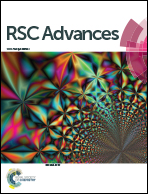Role of organic solvent addition to ionic liquid electrolytes for lithium–sulphur batteries†
Abstract
We investigate the role of the addition of an organic solvent to an ionic liquid electrolyte for the performance of lithium–sulphur (Li–S) batteries. We find that with a mixed electrolyte, formed by adding 10 wt% 1,3-dioxolane (DIOX) to an ionic liquid, the capacity of a Li–S cell is more than doubled, the rate capability and the cycling performance considerably improved, compared to a cell utilizing a neat ionic liquid electrolyte. The improved performance can be correlated with an enhanced ion transport, evidenced by an increased ionic conductivity and higher limiting current density, directly related to a decrease in viscosity and glass transition temperature of the mixed electrolytes. We show that this in turn is linked to a change in the local environment of the Li-ions where the organic solvent is incorporated in the coordination shell. In addition we show that the mixed electrolytes have a considerably higher thermal stability, in particular a dramatically increased flash point, and improved low temperature properties with respect to a conventional organic solvent based electrolyte currently used for Li–S batteries.


 Please wait while we load your content...
Please wait while we load your content...